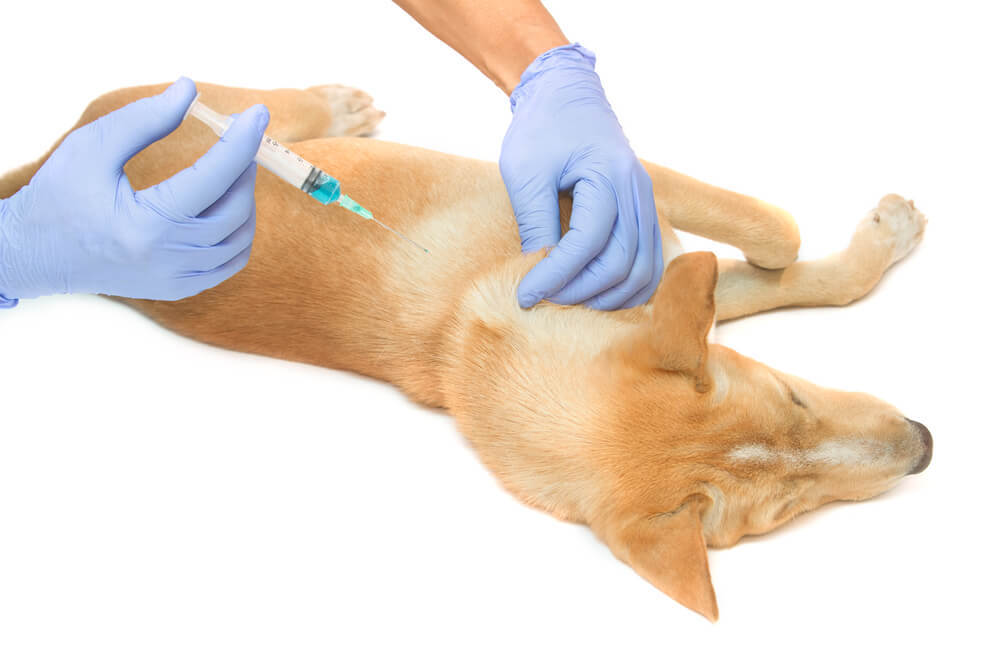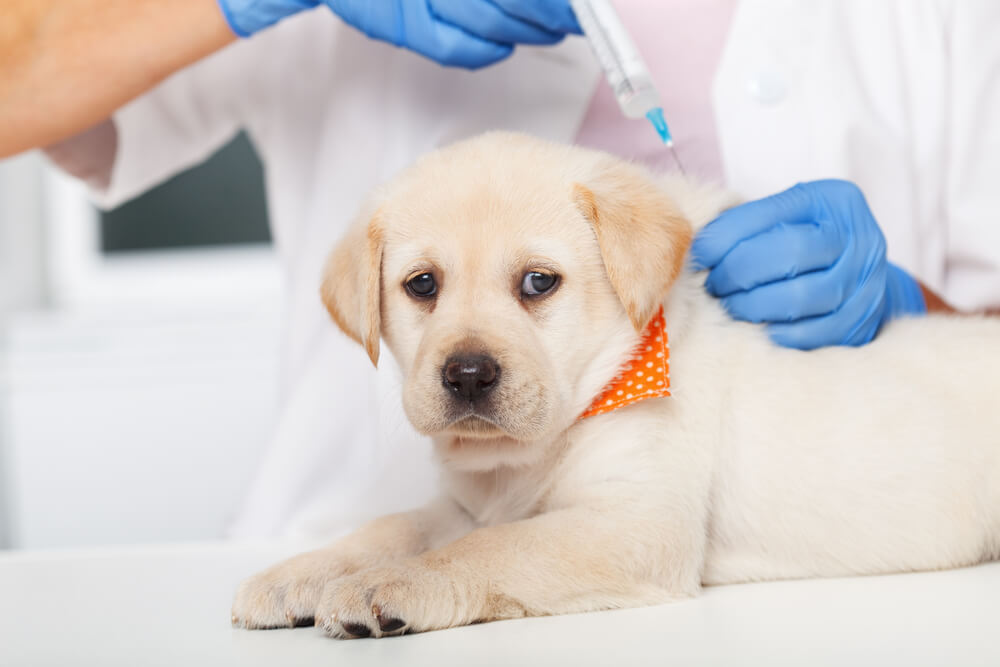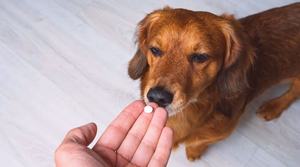
Reviewed & Fact-Checked by
Dr. Chyrle Bonk
Veterinarian (DVM)
Learn more about our Veterinary Review Board »
We know how upsetting it is to suspect that your dog has cancer. It can be even more painful to get the diagnosis. The good news is there are treatments that could extend your dog’s life and potentially put their cancer into remission.
This article explores what canine malignant lymphoma is, what causes it, signs, diagnosis, and how the disease is treated in dogs.
What is canine Malignant lymphoma?
Canine lymphoma is a cancer that affects the lymphatic system including the lymphatic vessels, lymph nodes and lymphatic organs.
The lymphatic system is responsible for several functions including the movement of waste products through the body, balance of bodily fluids, and immune response. This cancer can be localized to one area or spread throughout the body.
According to VCA Animal Hospital, lymphoma is a relatively common cancer, accounting for 15 – 20% of new cancer diagnoses in dogs.
There are four different types of lymphoma: multicentric, alimentary, mediastinal, and extranodal.
The difference in the types of lymphoma are based on where the cancer is located. They also vary in severity. For example, multicentric lymphoma is found in lymph nodes throughout the body, while mediastinal and alimentary are confined to specific sites-the chest and digestive tract respectively.
Dr. Chyrle Bonk, DVM
lymphoma Causes in Dogs
Unfortunately, the exact cause of lymphoma in dogs is not understood.
Several different possibilities have been studied, including:
- Viruses
- Bacteria
- Chemical exposure
- Physical phenomena like strong magnetic fields
Lymphoma is usually found in adult and senior dogs, we just don’t know what makes it happen.
As an owner the most you can do is feed your dog a healthy diet, make sure they get enough exercise, and try to reduce their exposure to harmful chemicals.
Even by doing all this, there is a chance your dog will develop lymphoma in their lifetime.
What are the Common Signs Of Canine Lymphoma?

What are the first signs of lymphoma in dogs?
It’s hard to know when our dogs are sick because they can’t tell us, but as owners we can see when our furry friends are not themselves.
The symptoms of lymphoma depend on the specific areas of the body where the cancer can be found.
The most common symptom are swollen lymph nodes. This is a sign of multicentric lymphoma, which accounts for 80 – 85% of all lymphoma cases in dogs.
The second most common type of lymphoma is alimentary, third is mediastinal.
Extranodal lymphoma is rare because it happens outside of the lymphatic system.
We've broken down the signs for each type of lymphoma found in your dog.
Multicentric Lymphoma
Location in the body:
Lymph nodes throughout the body.
Symptoms:
Enlarged lymph nodes around face, neck, chest, groin or backs of legs, lethargy, weight loss, unusual lumps or bumps
Alimentary Lymphoma
Location in the body:
Gastrointestinal tract
Symptoms:
Vomiting, diarrhea, weight loss
Mediastinal Lymphoma
Location in the body:
Chest
Symptoms:
Coughing, shortness of breath
Extranodal Lymphoma
Location in the body:
Organs outside of lymphatic system
Symptoms:
Varies greatly depending on organ(s) affected
As you can see, the symptoms of lymphoma in dogs can be widely varied depending on the type of lymphoma, location in the body and the stage of the tumor.
Many symptoms are general and could mean a lot of different things, which is why it’s important not to ignore any signs your dog is showing and get a professional opinion.
How is canine lymphoma diagnosed?

If you notice that your dog has enlarged lymph nodes, it’s important to have them assessed by a veterinarian and have a complete physical examination to determine the cause of any symptoms seen.
Swollen lymph nodes can be a sign of less serious issues like infections and autoimmune diseases, but for adult and senior dogs especially you will want to rule cancer out.
If lumps or bumps are found or if lymphoma is suspected, most vets will start with a fine needle aspirate. This involves taking a small sample of cells from the lymph nodes or affected organ and examining them under a microscope for evidence of cancerous cells.
If the fine needle aspirate ins't able to make a diagnosis or cannot be performed because of where the cancer is located, a biopsy of the tumor may be required. A biopsy involves the surgical removal of a tissue sample.
In addition to examining your dog’s cells, the vet may also perform other tests including a complete blood cell count, and serum biochemistry to assess the functioning of your dog’s internal organs.
Depending on the results of these initial tests and the type of lymphoma your vet finds, they may require staging tests and information to find out how far the disease has progressed to determine the best treatment and your dog’s prognosis.
How is canine Malignant lymphoma treated?
The methods and protocols used to treat lymphoma in dogs are very similar to those that are used to treat humans with lymphoma.
Chemotherapy is the most common and effective treatment protocol for lymphoma in dogs.
This treatment can extend your dog’s life from 9 – 13 months, but is not suitable for all lymphoma cases.
Most chemo treatments are administered via intravenous (IV) injection, although they also come in tablet or capsule form. If an IV catheter is used, a small section of your dog’s fur/hair will need to be shaved.
Luckily, when it comes to side effects of chemotherapy dogs don’t seem to have it as hard as humans do.
The most common side effects of dogs undergoing chemo are:
- Reduced appetite
- Lowered activity levels
- Mild vomiting and diarrhea
- Immune suppression
These symptoms usually last only one or two days after the treatment before subsiding.
If your dog suffers from more severe side effects, it’s important to talk to their professional care team. They may choose to lower the next dose of chemotherapy and can treat your dog’s symptoms.
After chemotherapy treatments most dogs with lymphoma enter remission.
It’s important here that you know the distinction between remission and being cured. When your dog is in remission it does not mean that they are cancer-free, it just cannot be detected using standard screening tests.
Surgery and/or radiation may be recommended in some cases of canine lymphoma but are not as common.
What is the prognosis for my dog?
How long will a dog live with malignant lymphoma?
The survival rate of canine lymphoma is a pertinent question for many pet parents.
Unfortunately the answer isn't that straightforward. Prognosis is heavily influenced by the type of lymphoma, the tumor stage, and choice of treatment.
Dogs diagnosed with lower grade lymphomas tend to live longer than dogs diagnosed with higher grade lymphomas.
Life expectancy for dogs receiving treatment can range anywhere from 6 months to 2+ years. If left untreated, life expectancy is much lower (4-6 weeks).
There are other factors to bear in mind that can affect the prognosis: your pet's age, overall health and stress.
Most, up to 90%, otherwise healthy dogs that are treated with chemotherapy for canine lymphoma will enter remission, and survive a year or more following diagnosis.
After care for dogs with lymphoma

How do you make your dog with lymphoma comfortable?
Your dog’s recovery from lymphoma treatment will depend greatly on the type of lymphoma they have and what their treatment entails.
No matter what, your dog will need a lot of rest since cancer and its treatments are hard on the body.
If your pup does require surgery, you will need to take extra care to keep their wounds clean. They may need to wear an e-collar, and you will have to save off-leash exercise for when their incisions have healed fully.
Depending on the location of the cancer and treatment, recovery can take from a few weeks to several months.



